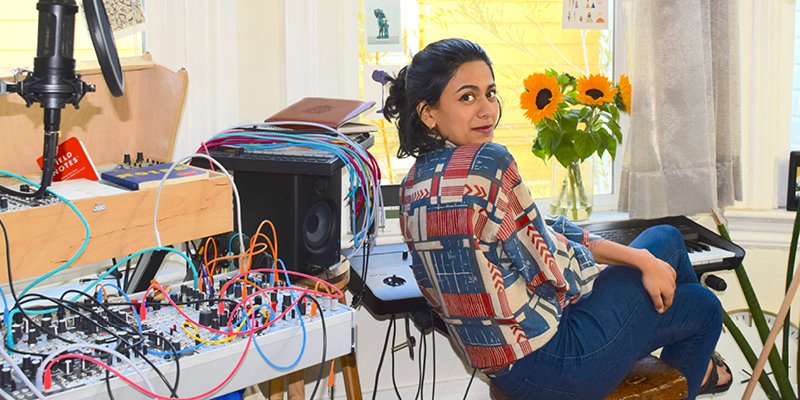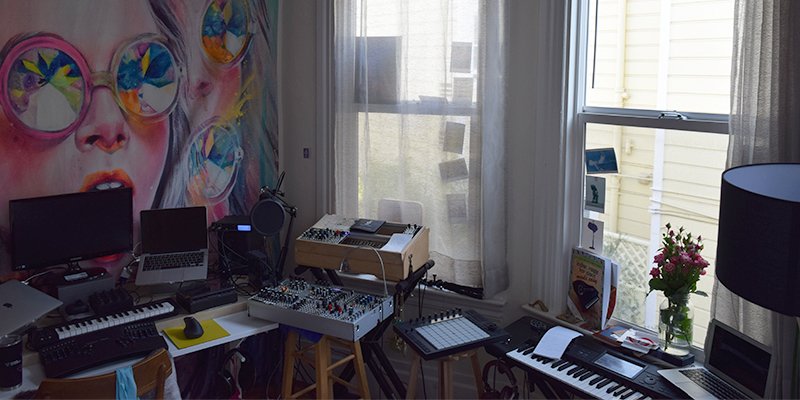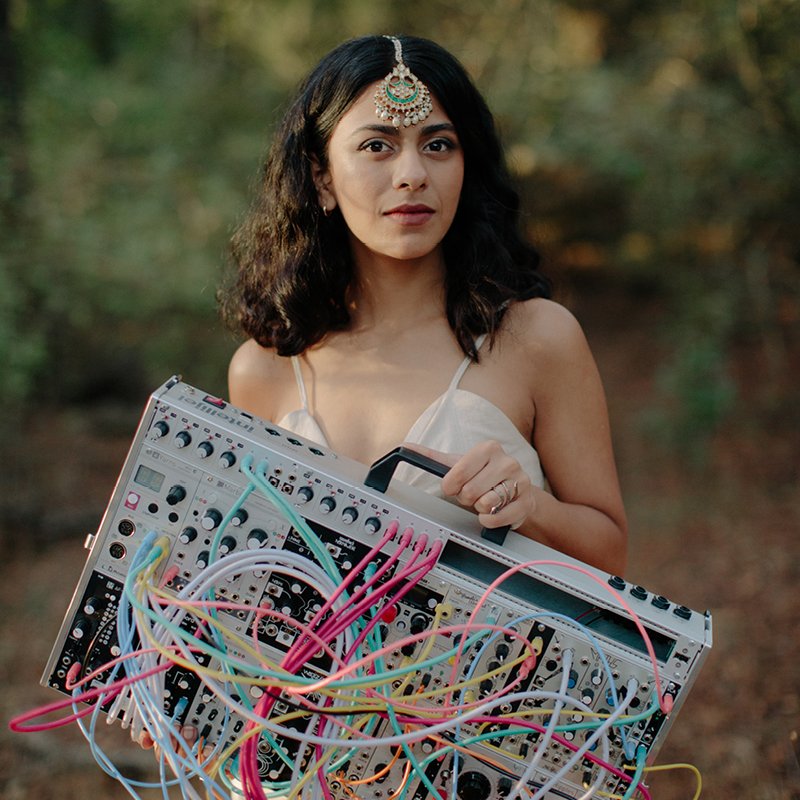Arushi Jain: I’m the Space in Between

Indian classical music may date back centuries but it’s in a perpetual state of flux. The tradition revolves around a complex melodic matrix known as a raag, or raga, that has no real translation in the Western classical system. There are countless raags, each of which contain a collection of notes, motifs and patterns that artists use to compose music in that raag’s framework. Depending on how a musician uses a raag’s properties, an endless number of melodies can be created.
“My teachers have described getting to know a raag as similar to getting to know a human,” describes the Indian artist Arushi Jain, formerly known as OSE. “The more time you spend with it, the more you start to identify their behaviors, habits, and unique characteristics.”
Armed with a modular synthesiser, her voice and Ableton Live, Jain produces lengthy raags that float between glistening ambient, moody drone and minimal glitch. These soundscapes are both experimental and deeply rooted in the spirit of Hindustani music – a classical idiom specific to northern India and distinct from the Carnatic classical tradition of southern India. Released on her own label Ghungru, her richly-hued rhythms and gossamer vocals are as absorbing as they are dense. "I’m not a Western classical musician or an Indian classical musician, I’m the space in between,” she describes over a video chat.
Raags have different moods depending on the time of day and context they’re played in – an idea reflected in her 2019 debut album With/Without. The album’s opener, “I Feel Incomplete Without Sound'' channels a morning raag, known as Raag Bhairavi, with its meditative and gentle tone. That’s followed by “Drown Out The Noise With Your Silence,” a more dynamic cut that takes its cues from the afternoon raag Bhimpalasi. This one is made for “afternoons sitting outside in the heat and watching animals roaming around,” says Jain. Her forthcoming album due in May, Under The Lilac Sky, is mostly influenced by evening raags.
“I don’t expect everyone to love my music but I want as many people as possible to hear it,” says the up-and-coming producer, and over the past year and a half, her work has already made waves in the international community. In addition to hosting regular radio shows on NTS and India’s boxout.fm, she’s also collaborated with a contemporary dance troupe and opened for legendary synthesizer artist Suzanne Ciani.
A tale of two educations: Hindustani music and coding
Jain's ability to reimagine traditional sonics on modular machinery comes after years of studies in classical music and computer science. As a child, she began intensive Hindustani vocal training that eventually took her to the prestigious Ravi Shankar Institute for Music and Performing Arts in her hometown of New Delhi. As part of the Mozart Choir of India, a collaboration between the Austrian embassy, the Ravi Shankar Institute and the Vienna Boys Choir, she was also exposed to Western classical music whilst touring India and Austria.
After moving to California to attend Stanford University, she dived into the field of engineering and studied coding. During this period, she stopped performing due to the intensity of her coursework but after taking a year off to work at technical non-profits in Kenya and Palestine among other countries, she returned to Stanford for her senior year with a desire to combine music and coding. One fateful class proved to be a game-changer for her career. “I took a class at the Centre for Computer Research in Music and Acoustics called Laptop Orchestra where you code a software-based instrument on your laptop using audio programming language,” she explains. “What I was essentially practicing in that class was instrument design philosophy and the whole world of sound synthesis. During those months, I realised that the way a human interacts and plays an instrument determines what sound comes from it."
This insight nudged her into making Hindustani-inspired music on non-traditional instruments. And it was perhaps no surprise that, as a coder, the modular synth became her tool of choice. "Why does a modular synth make sense to me? It’s a very simple concept. In coding, there’s a function, it’s a unit of work, you give it an input and you get a certain output depending on what’s happening in the function. You write a bunch of functions and once you’ve written them, you can figure out how you want to use them in your main program. You don’t care what's happening in the function, you just care about the inputs and outputs. It’s a way of organising work.”
"I’m not a Western classical musician or an Indian classical musician, I’m the space in between"
When she looked at a modular synth for the first time, her coding instincts instantly kicked in. On the synth, “I saw a bunch of contained units of work, i.e. inputs," she explains. "Modular synths are a different format than computer programming; controlled voltage instead of binary [code], but it’s the same concept where you have a unit of work and you match it with a certain function or module such as sound generators, modulation sources, etc. In my mind, these modules are different types of functions and each needs a certain kind of input to generate my expected output. That helps me create a visual map of what my sound circuit is doing.”
This visual ability is something she learned as an engineer along with knowing what a circuit is doing without necessarily knowing the exact outcome ahead of time. This kind of uncertainty may be unsettling for some, but Jain is quite accustomed to it. As a full-time senior software engineer at Reddit, she’s used to chaos. She works on the software that other engineers use to write code, which makes her a kind of systems architect – a position that requires some of the same set of skills as working with modular architecture. “My job requires me to look at a problem and know enough of the entire system so I can pinpoint where the problem is,” she explains. “It’s all relational, which is so similar to how a synth works. If one service isn’t working, I need to know what is happening on all the connected services so I can trace to the original source of the problem.”
Not one to sit still, she's also dabbled in coding audio – she once wrote her own synthesizers in Python on top of Reddit’s data. "At some point, I’m sure I will start coding the modules on my synth,” she says. “I can write code to run on any of the modules but I haven’t invested much time into that world yet. I code all day at work so when I come to my musical space, I don’t always want to keep doing it."

Arushi Jain’s former home studio
Composing raags
In writing mode, Jain, who sometimes uses the alias 'Modular Princess,' begins by composing with her voice, the harmonium or keys. “Even when I write harmonies, I hum them out first and go from there,” she explains. Whilst most modular artists use built-in sequencers, she uses Ableton Live to sequence due to the sheer length of her melodies. “This is an idea borrowed from Western classical music because in Indian classical, the composer and performer are one. If you’re a good Indian classical musician, you’re composing and performing on the spot. My first instrument was my voice, so when I first started writing music, I was borrowing from the Western classical world where the composer is separate from the performer."
After sequencing, she turns to sound design. “That’s very different from the way a lot of other people write because for most, composition and sound design go hand in hand,” she points out. “That’s also not the modular synth way of doing things because most modular artists don’t compose as much.” To sync her synth with Ableton, she uses a Mutable Instruments MIDI to CV converter module called Yarns.

Arushi Jain with her modular synth
For performances, she usually writes compositions with a certain time of day in mind to perform and depending on that, she’ll pick a raag to reinterpret. “I’ll first study the raags and listen to the greats such as Nikhil Banerjee and Ali Akbar Khan. I also go back to the compositions that I’ve previously learnt and analyse their form and structure to get inspiration as I write my own compositions.”
Her raags differ from traditional versions because of her use of melodies and harmonisation that don’t exist in Indian classical. "Because I’m writing for a computer, the speed at which I’m playing the notes is often way faster than the greats,” she says. “I also layer my music a lot. Indian classical is lead-based, you have one person playing at one time and it’s about conversation between different instrumentalists who riff off each other because it’s so improvisational. Since I’m a solo artist, I have multiple melodies playing at once. It’s almost like an orchestra."
In a wider sense, this very departure from tradition can be seen as perfectly fitting within the tradition. Recalling a conversation with Anoushka Shankar, Jain recounted how the late Ravi Shankar's daughter described Indian classical music as “constantly changing, constantly being brought into the modern era because there’s so much improvisation.” This spirit applies equally to modular synth and computer as it does to sitar and tabla and explains why Arushi never plays others’ compositions. “Although you can do that in Indian classical music, you have to change it, usually via improvisation, so that it becomes unique to you," she explains. "My teachers say, it has to become a part of you."
Microtonal music on tools built for Western scales
India’s traditional music is microtonal, i.e. it contains notes and tunings that don’t fit into the Western twelve-tone system of equal temperament, so it’s usually played on instruments that accommodate microtonality. The modular synth isn’t one of them, however, so it’s hard for Jain to improvise live.
"I feel a certain rigidity with the way I perform live because there’s not much room to do free-form microtonal music on the modular synth in the way my music demands it,” she explains. “Indian classical music comes from the sitar, the veena, the sarod – instruments that have built-in control over microtonality, but that kind of control doesn’t exist on my instrument. Logic allows me to de-tune a scale but on the modular synth, I can only do absolute tuning. If I’m playing a C note, I can de-tune that but it will de-tune all my notes across the scale. What I want to be able to do is de-tune certain notes and change the interval between notes but that’s not something I can do in Ableton or at least I haven’t figured out how to yet."
It’s an entirely different situation for acoustic instruments. Indian pianist Utsav Lal, for example, tunes the piano to play certain raags but that’s tricky for Jain to do because she works with MIDI, a universal musical communication protocol specifically developed for Western equal temperament. Difficult to customise, it is a glaring example of ingrained cultural bias in electronic music production. “Everything in electronic music is based in MIDI and there’s not a lot of room to get something to sound good in a different scale,” she says.
In response to these challenges, Iraqi-British composer and researcher Khyam Allami has created two browser-based tools that premiered at Germany’s CTM Festival in January. One, called Leimma, allows users to build their own tunings. Producers can then use these to compose microtonal music on Apotome, a sister application. According to Jain, this is a step in the right direction but “at the end of the day, a musician has to be able to execute on their own instrument, not on another platform,” she notes. More recently, Ableton has released Microtuner, a MIDI device that lets you import, edit and generate microtonal scales.
Seeking to expand the way she performs, she is now incorporating the piano into her live setup to enable more improvisation. That will give her more room to play with traditional raags, which she’s so far used as reference points for her own compositions.
Going forward, she hopes to dig deeper into the idea of Indian classical music being played on non-traditional instruments such as the violin, guitar and harp. “Composers like Amjad Ali Khan, I’m obsessed with him,” she raves. “He’s collaborated with full-blown orchestras and taught them how to play Indian classical music and it sounds gorgeous. It opens up your mind to the sound and slowly you can make your way to the more traditional works. This is a theme I want to explore more in my NTS show."
Text and interview: Nyshka Chandran
Keep up with Arushi Jain on Instagram and Bandcamp
Photos by Avarna Jain